#International Sanskrit Day
Explore tagged Tumblr posts
Text
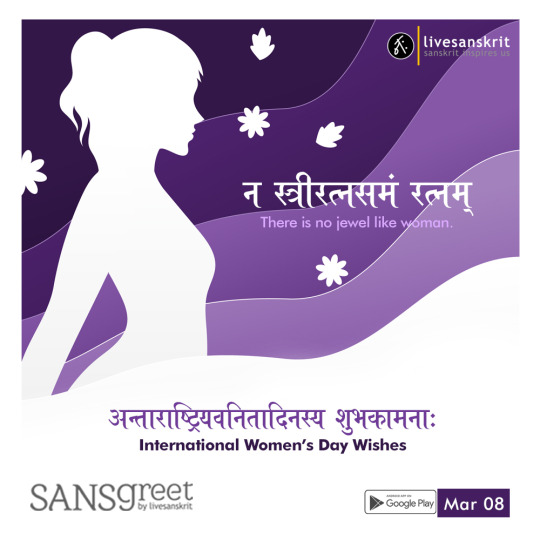

Send from Sansgreet Android App. Sanskrit greetings app from team @livesanskrit .
It's the first Android app for sending @sanskrit greetings. Download app from https://livesanskrit.com/sansgreet
International Women's Day.
International Women's Day (IWD) is a global holiday celebrated annually on March 8 to commemorate the cultural, political, and socioeconomic achievements of women. It is also a focal point in the women's rights movement, bringing attention to issues such as gender equality, reproductive rights, and violence and abuse against women.
#sansgreet #sanskritgreetings #greetingsinsanskrit #sanskritquotes #sanskritthoughts #emergingsanskrit #sanskrittrends #trendsinsanskrit #livesanskrit #sanskritlanguage #sanskritlove #sanskritdailyquotes #sanskritdailythoughts #sanskrit #resanskrit #womensday #indianwomen #womenempowerment #womenleaders #she #women #lady #internationalwomensday #womensday2022 #womenspower #womensupportingwomen #celebratingsanskrit #happywomensday #mother
#greetingsinsanskrit#sanskritgreetings#sanskrittrends#trendsinsanskrit#livesanskrit#sanskrit#celebratingsanskrit#incredibleindia#womensday#international women's day
0 notes
Text
File: Volkov, Vespera Anetka
Alias: Winter Widow
Status: classified

File Last updated: July 4, 2023 AD
———
Age: 15
Class: 16ABX
Graduation Year: 2023
Origin: Romania
Birthday: August 11, 2008
Ethnicity: Caucasian
Handlers: Krista Udova(62431), Milunka Dulovna(90218), Melina Vostokov(Iron Maiden)
Trainers: Winter Soldier(Barnes, James B.), Taskmaster(Dreykov, Antonia)
Track: Field Agent(undercover; weapons specialist)
Appearance
Eye color: gray
Hair color: black
Skin: white; pale
Build: tall, lean, bony
Height: 5’9.79”
Weight: 101.235lbs
Notable markings:
birthmark;right thigh back, oblong Burn scar; left ankle, inside, 4”x 3”x 9”
Specialty Training
- Figure Skating
Began: 2 years
Training time: 6hrs every other day, 17hrs every Thursday and Monday
On track to the Winter Olympic Games. Reliably lands quads, possible pairing with Hydra 20180 for pair skating.
- Deadlift
Began: 6 years
Training time: 1hr daily
Will reach national record by 2028
Current capacity: 480lbs
- Combat Mimicry
Began: 7 years
Can mimic opponent’s fighting style closely. Taught by Taskmaster
- Biochemistry
- Codebreaking
- linguistics
Languages
Spoken: Russian, English, Norwegian, Welsh, Polish, Romanian, Spanish, Portuguese, French, Qubecois, Italian, Latin, Ancient Greek, Greek, Old English, Cantonese, Japanese, German, Hebrew, Sanskrit, Korean, Swedish, Hindi, Punjabi, Pennsylvania Dutch and Scots Gaelic
Written: braille, Russian, English, Norwegian, Welsh, Polish, Romanian, Spanish, Portuguese, French, Qubecois, Italian, Latin, Ancient Greek, Greek, Old English, Cantonese, Japanese, German, Hebrew, Sanskrit, Korean, Swedish, Hindi, Punjabi, Pennsylvania Dutch and Scots Gaelic
Read: braille, Russian, English, Norwegian, Welsh, Polish, Romanian, Spanish, Portuguese, French, Qubecois, Italian, Latin, Ancient Greek, Greek, Old English, Cantonese, Japanese, German, Hebrew, Sanskrit, Korean, Swedish, Hindi, Punjabi, Pennsylvania Dutch and Scots Gaelic
Other: American Sign Language, Russian Sign Language, International Sign, Morse code
Status
[section redacted]
Role
- replace the Iron Maiden following graduation
- should Taskmaster Program default, replace Winter Soldier and Taskmaster
- restore Red Academy-HYDRA control over XXXXXXXXX
Miscellaneous
— favored by Lt.Borisov
- Untouchable Status — RE; Grad Mission
- Enforced Separations — not allowed with peers without supervision, initiated 2015
- extremely exemplary when undercover in Queer Rebellion Groups, Lesbian Covers reccomended
Graduation Mission Assign.
Seduce XXXX XXXXXXX as debutant Gabrielle La Aubrey(CF61789), knock out with C19JL1990 formula(oral component), identify and procure XXXXXX XXXXX through whirlwind romance focusing on subject’s romantic beliefs. XXXXXXX has taste for young virgin women, will have just inherited full title/shares; foolish party persona crafted. Deep Cover in France; 6 weeks, fake family emergency and return with items. (Summary)
Part II
#files from the past#the winter widow#vera volkov#marvel rp#mcu#marvel#mcu rp#marvel mcu#marvel ask blog#marvel cinimatic universe#lore drop
95 notes
·
View notes
Text
Happy International Yoga Day!

Today we celebrate the ancient practice of yoga, which has been a cornerstone of Indian culture for over 5,000 years. We honor the "Father of Modern Yoga," Tirumalai Krishnamacharya (1888-1989), who played a crucial role in popularizing yoga worldwide. We also honor the original "Father of Yoga," Patanjali, who authored the celebrated yoga sutras.
_History of Yoga:_
Yoga has its roots in the Indus Valley Civilization, with evidence of yoga practices dating back to 3000 BCE. The word "yoga" comes from the Sanskrit word "yuj" meaning "to unite." Over time, yoga evolved through various traditions, including Hatha Yoga, Raja Yoga, and Bhakti Yoga.
Patanjali:
Patanjali was a Hindu author, mystic, and philosopher who authored the Yoga Sutras, a categorization of yogic thought arranged in four volumes. He is regarded as an avatar of Adi Sesha and is believed to have lived between the 2nd century BCE and the 5th century CE ¹.

Tirumalai Krishnamacharya:
Born in 1888, Krishnamacharya was a Indian yoga master, ayurvedic healer, and scholar. He studied yoga under his father and later under the revered yoga guru, Rama Mohan Brahmachari. Krishnamacharya went on to teach yoga to prominent students, including B.K.S. Iyengar, K. Pattabhi Jois, and Indra Devi, who spread yoga globally.
BENEFITS OF YOGA
Yoga offers numerous benefits, including:
- Improved flexibility and strength
- Reduced stress and anxiety
- Enhanced mental clarity and focus
- Improved overall well-being

Popular Yoga Asanas:
1. Downward-Facing Dog (Adho Mukha Svanasana)
2. Warrior Pose (Virabhadrasana)
3. Triangle Pose (Trikonasana)
4. Seated Forward Fold (Paschimottanasana)
5. Tree Pose (Vrksasana)
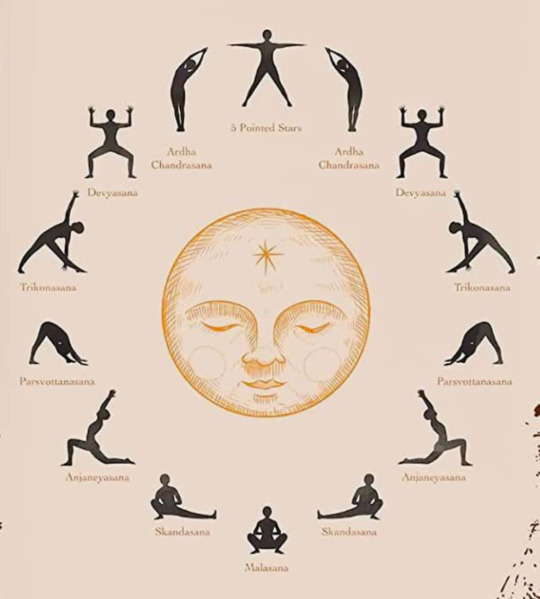
#InternationalYogaDay#YogaForAll#desiblr#desi tumblr#desi girl#being desi#desi tag#desi aesthetic#yoga#indian culture#health and wellness#desi#international yoga day#hinduism#hindublr
45 notes
·
View notes
Text

Soul Body The soul body generates electromagnetic energy in the form of visible light, which is interconnected with our chakras. This energetic field, often referred as our “aura,” changes based on our emotional or physical well-being. The word aura comes from the Sanskrit words, aur and wer, meaning to “raise or hold suspended.” In yogic tradition, Kundalini energy or “serpent power” rises from the root chakra to the crown.
Serpents are ancient symbols of transformation and growth that represent the harmonious duality of life and death, light and dark, good and evil. In Hebrew, these “serpents of fire and light” were known as seraphim, the angelic beings who protected the “throne of god” in the Seventh Heaven.
In Judaic mysticism, Uriel is the archangel of wisdom, who gave the book of secrets to Metatron. In Kabbalistic thought, this wisdom is the way of the return through the “Tree of Life”.
In Greco-Roman tradition the two serpents on the Caduceus of the messenger gods Hermes and Mercury, were symbols of peaceful power and diplomacy. In alchemy, two serpents represented the balance of opposing forces. This is similar to the Taoist philosophy of yin-yang. Yin is the silvery moon energy (female/night) that receives light. Yang is the golden sun energy (male/day) that penetrates dark. They create life in a harmonious dance between chaos and peace.
By imagining these two serpents of light moving in harmony through the seven worlds of our chakras we can create balance within our self.
Message: This is a time to create balance in all areas of life. If we are feeling stuck or are in chaos, remember that this is temporary, for all things change. Imagine being at peace with change as an opportunity to create a new way of being. By connecting with our chakras, we can improve our internal flow of life force energy, and find the peace we need within us.
“It is not the body, nor the personality, that is the true self. The true Self is eternal. Even on the point of death we can say to ourselves. My true Self is free. I cannot be contained.” – Marcus Aurelius –
Chakra – Color – Seven Worlds Root – Red – Physical World Sacral – Orange – Emotional World Solar Plexus – Yellow – Mythic World Heart – Green – Energetic World Throat – Blue – Past World Third Eye – Violet – Present World Crown – White – Future World
40 notes
·
View notes
Text
Below are 10 featured Wikipedia articles. Links and descriptions are below the cut.
The election in 1860 for the position of Boden Professor of Sanskrit at the University of Oxford was a competition between two candidates offering different approaches to Sanskrit scholarship. One was Monier Williams, an Oxford-educated Englishman who had spent 14 years teaching Sanskrit to those preparing to work in British India for the East India Company. The other, Max Müller, was a German-born lecturer at Oxford specialising in comparative philology, the science of language.
Adolfo Farsari (Italian pronunciation: [aˈdolfo farˈsaːri]; 11 February 1841 – 7 February 1898) was an Italian photographer based in Yokohama, Japan. His studio, the last notable foreign-owned studio in Japan, was one of the country's largest and most prolific commercial photographic firms. Largely due to Farsari's exacting technical standards and his entrepreneurial abilities, it had a significant influence on the development of photography in Japan.
Girl Pat was a small fishing trawler, based at the Lincolnshire port of Grimsby, that in 1936 was the subject of a media sensation when its captain took it on an unauthorised transatlantic voyage. The escapade ended in Georgetown, British Guiana, with the arrest of the captain, George "Dod" Orsborne, and his brother. The pair were later imprisoned for the theft of the vessel.
Abu Muhammad Hasan al-Kharrat (Arabic: حسن الخراط Ḥassan al-Kharrāṭ; 1861 – 25 December 1925) was one of the principal Syrian rebel commanders of the Great Syrian Revolt against the French Mandate. His main area of operations was in Damascus and its Ghouta countryside. He was killed in the struggle and is considered a hero by Syrians.
Marjorie Cameron Parsons Kimmel (April 23, 1922 – July 24, 1995), who professionally used the mononym Cameron, was an American artist, poet, actress and occultist. A follower of Thelema, the new religious movement established by the English occultist Aleister Crowley, she was married to rocket pioneer and fellow Thelemite Jack Parsons.
Maya stelae (singular stela) are monuments that were fashioned by the Maya civilization of ancient Mesoamerica. They consist of tall, sculpted stone shafts and are often associated with low circular stones referred to as altars, although their actual function is uncertain. Many stelae were sculpted in low relief, although plain monuments are found throughout the Maya region. The sculpting of these monuments spread throughout the Maya area during the Classic Period (250–900 AD), and these pairings of sculpted stelae and circular altars are considered a hallmark of Classic Maya civilization.
The North Norfolk Coast Site of Special Scientific Interest (SSSI) is an area of European importance for wildlife in Norfolk, England. It comprises 7,700 ha (19,027 acres) of the county's north coast from just west of Holme-next-the-Sea to Kelling, and is additionally protected through Natura 2000, Special Protection Area (SPA) listings; it is also part of the Norfolk Coast Area of Outstanding Natural Beauty (AONB). The North Norfolk Coast is also designated as a wetland of international importance on the Ramsar list and most of it is a Biosphere Reserve.
Preening is a maintenance behaviour found in birds that involves the use of the beak to position feathers, interlock feather barbules that have become separated, clean plumage, and keep ectoparasites in check. Feathers contribute significantly to a bird's insulation, waterproofing and aerodynamic flight, and so are vital to its survival. Because of this, birds spend considerable time each day maintaining their feathers, primarily through preening.
The Wells and Wellington affair was a dispute about the publication of three papers in the Australian Journal of Herpetology in 1983 and 1985. The periodical was established in 1981 as a peer-reviewed scientific journal focusing on the study of amphibians and reptiles (herpetology). Its first two issues were published under the editorship of Richard W. Wells, a first-year biology student at Australia's University of New England. Wells then ceased communicating with the journal's editorial board for two years before suddenly publishing three papers without peer review in the journal in 1983 and 1985. Coauthored by himself and high school teacher Cliff Ross Wellington, the papers reorganized the taxonomy of all of Australia's and New Zealand's amphibians and reptiles and proposed over 700 changes to the binomial nomenclature of the region's herpetofauna.
Wulfhere or Wulfar (died 675) was King of Mercia from 658 until 675 AD. He was the first Christian king of all of Mercia, though it is not known when or how he converted from Anglo-Saxon paganism. His accession marked the end of Oswiu of Northumbria's overlordship of southern England, and Wulfhere extended his influence over much of that region.
26 notes
·
View notes
Text
Anonymous asked: Of all the many languages you speak which is your weakest one? Do you use those languages?
It’s privilege to learn any language that isn’t your mother tongue. As Ludwig Wittgenstein correctly observed, “The limits of my language means the limits of my world”. If English is our native tongue we put ourselves at a disadvantage because we expect every other nationality to take the trouble to speak it. There seems no incentive to learn a foreign language. We become lazy not just in language but also in other ways including our cultural enrichment, our imagination, and a misplaced sense of our self-importance in the world.

Of the European languages I know, I probably think German would be my weakest. When I was in school in Switzerland you’re brought up in three languages: French, Italian, and German (even if the Swiss speak Swiss German). When I say weakest I mean I can converse fluently, but I don’t have time to read German literature in the same immersive way I would say with French literature or take any special interest in German affairs.
I would say I’m fairly fluent in French now but still prone to silly mistakes. I’ve been told that I can speak without an accent and that is heart warming to know, because that was always the goal once I moved here to France. I don’t really use French in my work as it’s a multi-national entity and so English is the default language of corporate world, but I’m speaking French pretty much the rest of the time outside of work.
I was extremely fortunate to be born into a multi-lingual family where Norwegian and English were spoken from birth. All my siblings were being versed in Latin (not Greek which came years later after doing Classics at university) by the time I was 8 or 9 years old because my father was a classicist and he felt Latin was the building blocks to mastering other languages.
All this occurring whilst we moved lived and moved around a lot in the world such as China, Japan, India, and the Middle East. When I was initially sent to one of the first of my English girls boarding schools I was horrified that most of the girls only spoke English. I thought I was the stupid one for only knowing 6. Boarding school, if nothing else, gave me a great privilege to hone in on the languages I did know and start to learn others.
My parents didn’t take the easy way out and put us children in international schools like all the other expat children. That would have been too easy given how tight knit the British expatriate community was out there. Instead we were left to sink or swim in local schools in places like Tokyo and Kyoto in Japan or Shanghai in China or in Delhi, India. It was a struggle but you soon find your feet and you stumble towards some basic level of fluency.
I’m fortunate that before Covid my corporate work took me often to the Far East and it was a great opportunity to hone what I already knew. The result is I can converse and take business meetings in Chinese and Japanese (though English gets thrown into the mix too).

I would say Chinese is more of a struggle for me these days because I’ve not been back since before the Covid lockdown in 2020. Chinese is one of those languages that can easily melt away if you don’t get the chance to converse in it on a regular basis. Japanese less so, probably because the culture had more profound impact on me than Chinese culture.
Hindi is less of an issue because I have close Indian friends and also I watch Bollywood movies as well as converse with Indian immigrants here in Paris who have local stores. Urdu I learned through the backdoor because Urdu has a spoken affinity with Hindi (if you know Hindi then you know spoken Urdu, more or less, especially in Northern India and cities like Delhi where Urdu was born in the burnt ashes of Mughal India). Reading is another matter because they each use different scripts - Sanskrit for Hindi and Arabic and Persian script for Urdu.
Strangely enough when I was doing my tour in Afghanistan years ago with the British army, I would speak Urdu with local Afghans who served as official translators or were selling goods on the base. These Afghans knew Urdu because an entire generation of Afghan boys and girls grew up in refugee camps on the Pakistani border during the different phases of the Afghan war. I have very fond memories of their friendship and hospitality, but less so of the war itself.
With Arabic, it had lapsed woefully until I did a posting in Dubai in the past year (as catalogued in my blog) and I found myself suddenly remembering a lot and asking Arab friends. Soon I was able to hold my own amongst my colleagues and corporate clients. In these cultures it’s really hard to stay focused because so many of them speak very good English. So it’s hard to get them to stick with their own language because you want to learn from them - but they want to show off their English proficiency - and so you have to be polite but persistent to stick with Arabic.
If you’re learning a new language then I hope you stick with it. There’s almost nothing more rewarding in your life than the disocovery a rich culture through language. The key is to find a way to make it fun rather than a trip to the dentist chair for a root canal operation.

Thanks for your question.
86 notes
·
View notes
Photo

HAPPY INTERNATIONAL FAIRY DAY!!! International Fairy Day, reputedly started by artist Jessica Galbreth, celebrates fairies, the mythological creatures of folklore. The term "fairy" goes back to Europe in the Middle Ages, but similar creatures were mentioned prior, including the gandharvas in ancient Sanskrit texts, nymphs of Greek mythology, jinni of Arabic mythology, and others. Fairies were closely tied to Celtic culture and were seen as being intelligent, magical, and mischievous
Source - https://mewe.com/p/bikinisummer
33 notes
·
View notes
Text
Happy International Day of Yoga!!
Today we celebrate the International Day of Yoga. This worldwide celebration wants to spread awareness about holistic health and fitness by practising a millenary discipline such as Yoga. This year’s International Yoga Day 2023 theme is Vasdhaiv Kutumbakam. Vasudhaiva Kutumbakam – वसुधैव कुटुम्बकम् is a Sanskrit phrase that literally means ‘the whole world is a single family‘ or ‘the world is…

View On WordPress
#Adho Mukha Svanasana#Balasana#Bhujangasana#International Day of Yoga#Raffaello Palandri#Raffaello Palandri Yoga#Savasana#Tadasana#Utthita Trikonasana#Virabhadrasana I#Vrksasana#Yoga
25 notes
·
View notes
Text
International Mother Language Day:History and Significance
For the people of Bengal as well as language advocates and linguists worldwide, International Mother Language Day is a day of enormous importance. Every year on February 21st, the day is commemorated to encourage multilingualism and linguistic diversity, as well as to remember the sacrifices made by language activists in Bangladesh during the Bengali Language Movement.
In the early 1950s, a political and social movement called the Bengali Language Movement emerged in East Pakistan (modern-day Bangladesh). It was a demonstration against Pakistan’s 1948 declaration of Urdu as its sole national language. The majority of East Pakistanis who spoke Bengali believed that the action was discriminatory and infringed their rights to their language and culture. They pushed for the inclusion of Bengali as one of Pakistan’s official languages.
The demonstrations started on February 21, 1952, when Dhaka University students and members of the general public demanded that Bengali be granted the same status as Urdu. In a violent response, the police opened fire on the demonstrators, killing several of them. In East Pakistan, the incident provoked a wave of protests and turmoil.
Together with language, cultural identity, and political independence were also important aspects of the Bengali Language Movement. Intellectuals, students, and political figures led the campaign, seeing language as a means of asserting their rights and seeking a greater say in the affairs of the country. Bengali was eventually recognised as one of Pakistan’s official languages in 1956 as a result of the struggle.
International Mother Language Day, which was established by the UN in 1999, honours the history of the Bengali Language Movement and the sacrifices made by its participants. The purpose of the day is to encourage linguistic and cultural diversity and to increase awareness of the value of mother tongues for social cohesion, education, and communication.
International Mother Language Day is a day of cultural celebration and national pride for the people of Bangladesh. Cultural activities, processions, and the laying of wreaths at the Shaheed Minar (Martyr’s Monument), which was erected in Dhaka in honour of the language martyrs who died on February 21, 1952, commemorate the day. The structure serves as a reminder of the significance of Bengali to Bangladeshis.
The Bengali language is an integral part of the cultural heritage of Bangladesh, as well as of the Indian subcontinent. With more than 250 million speakers, it is the sixth most widely spoken language in the world. Some of the greatest works of literature, poetry, and music in the area were written in Bengali, a language with a long literary history that dates back to the ninth century.
The language of Bengali has also changed over time as a result of the shifting demands and aspirations of its speakers. Sanskrit, Persian, Arabic, English, and other Indian subcontinental languages have all had an impact on it. This has given the language a distinctive grammar and syntax, as well as a rich and varied vocabulary.
In conclusion, International Mother Language Day is an important day for language advocates and linguists around the world, as well as for the people of Bangladesh. This day honours the diversity of languages and cultures and the sacrifices made by the Bangladeshi language martyrs. Bengali language activists and those who support linguistic diversity continue to be inspired by the Bengali Language Movement, which was a pivotal time in the history of the Indian subcontinent.

#bengali#bangla#india#bangladesh#langblr#assam#west bengal#বাংলা#tripura#desi#language learning#international mother language day#languages#kolkata#literature
50 notes
·
View notes
Text
Celebrating International Yoga Day on 21st June 2024, Theme "Yoga for Self and Society"
The summer solstice brings not just longer days but also a global celebration of wellness – International Yoga Day! Marked annually on June 21st, this day serves as a powerful reminder of the ancient practice's profound impact on individuals and society as a whole. This year's theme, "Yoga for Self and Society," beautifully captures the essence of yoga – a practice that cultivates not just physical well-being but also a sense of connection and harmony within ourselves and with the world around us.

Yoga for Self: Cultivating Inner Peace and Well-being
Yoga, derived from the Sanskrit word "yuj," meaning "to yoke" or "to unite," embodies the philosophy of bringing harmony to the mind, body, and spirit. Whether you're a seasoned yogi or a curious beginner, International Yoga Day is the perfect time to explore the many benefits this practice offers for your "Self."
Stress Reduction: The world can be a stressful place. Yoga, with its emphasis on mindful breathing and gentle movement, is a proven stress reliever. Studies show that regular yoga practice can lower cortisol (the stress hormone) levels, promoting feelings of calm and well-being.
Improved Flexibility and Strength: Yoga isn't just about stretching – it also incorporates strengthening poses that build muscle tone and improve flexibility. This combination can not only enhance your physical capabilities but also improve posture and reduce the risk of injuries.
Enhanced Body Awareness: Yoga encourages you to pay attention to your body's sensations and movements. This heightened awareness can help you identify areas of tension or discomfort and ultimately lead to a deeper connection with your physical self.
Mental Clarity and Focus: The practice of focusing on your breath during yoga poses can help quiet the mind and improve concentration. This can translate into improved focus in your daily life, whether at work, school, or simply navigating a busy day.
Try Yoga Burn Challenge to find your inner peace and Happiness
Yoga for Society: Fostering Connection and Harmony
This year 2024 the international yoga day theme "Yoga for Self and Society" underscores the importance of how yoga's benefits extend beyond the individual. As we cultivate inner peace and well-being through our practice, we contribute to a more peaceful and harmonious society as a whole.
Building Community: Yoga classes provide an opportunity to connect with like-minded individuals who share your interest in wellness. These connections can foster a sense of belonging and community, essential for a healthy society.
Promoting Empathy and Compassion: The core principles of yoga, such as ahimsa (non-violence) and aparigraha (non-possessiveness), encourage empathy and compassion. As we integrate these values into our practice, we can extend them into our interactions with others, fostering a more caring and compassionate world.
Promoting Global Wellbeing: International Yoga Day serves as a reminder that yoga is a practice for everyone, regardless of nationality, religion, or background. By coming together on this day to celebrate yoga, we promote a sense of global unity and well-being.
You may also like : 6 Yoga Poses for Memory Mastery
Celebrating International Yoga Day on 21-06-2024 : Unroll Your Mat and Join the Movement
There are countless ways to participate in International Yoga Day 2024. Here are a few ideas:
Join a Local Event: Many communities organize yoga sessions or workshops on International Yoga Day. Look for events in your area and connect with others who share your passion for yoga.
Practice at Home: If attending an event isn't an option, you can still celebrate by practicing yoga at home. There are numerous online resources and yoga apps that offer free or subscription-based classes for all levels.
Introduce Yoga to a Friend or Family Member: Share the gift of yoga by inviting a friend or family member to join you in practicing. It's a fantastic way to introduce them to the benefits of this ancient practice.
Invest in Your Practice: The Importance of a Quality Yoga Mat
No matter how you choose to celebrate International Yoga Day on 21-06-2024, having a reliable yoga mat is essential. An anti-skid yoga mat provides the stability and support you need to perform poses safely and comfortably.
Looking for the perfect companion for your International Yoga Day celebration explore at amazon, a wide range of high-quality, anti-skid yoga mats! These mats offer superior grip, cushioning, and support, ensuring a safe and comfortable practice for all levels. Visit today to find the perfect mat for your yoga journey!
Please do remember, Yoga is a practice, not a competition. Be kind to yourself, listen to your body, and most importantly, enjoy the journey towards a more peaceful and mindful you. Happy International Yoga Day.
Read More: How to Practice Naked Yoga
#International Yoga Day#Yoga Day 2024 theme#International yoga day 2024 theme#21 -06-2024 yoga day theme#International Yoga Day 2024 Venue#naked yoga#nude yoga#yogadaily#yoga positions#yoga for seniors#yoga practice#yoga pose#yoga postures#yoga motivation#yoga inspiration#nude yoga classes#naked yoga classes#yogainspiration#fitnessmantram#fitnessjourney#10th International yoga day theme
3 notes
·
View notes
Text
♡ Layla Ansari Character Sheet (Hogwarts Legacy) ♡

*Please note that our sketch artist is an intern. Once our budget increases, we will be recruiting for a more talented professional.
General Information
Full Name: Layla Rahmi Binti Mehmood Ansari
Nationality: Dual Citizen of British Raj (British India) and Ottoman Empire (Present Day Turkey), Indefinite Leave to Remain (ILR) for UK (equivalent to permanent resident in USA)
Ethnicity: South Asian (a princely state not currently under British rule)
Blood Status: Pureblood (information retrieved from ILR application)
Height: 5'7 or 170cm
Gender: Female
Languages: English, Hindi/Urdu, Turkish, Arabic (levantine dialect), Kashmiri, Punjabi, Farsi, Yoruba, Sanskrit (read only), Latin (read only)
House: Wolverine (Durmstrang), Slytherin (Hogwarts)
Boggart: [REDACTED]
Amortentia: [UNKNOWN]
Criminal History: [EXPUNGED]
Patronus: [REDACTED]
Future Occupation: [REDACTED]
Love Interest: Ominis Gaunt
Best Friends: Ominis Gaunt, Sebastian Sallow, Imelda Reyes, Amit Thakkar
Background: [MISSING INFORMATION]
Family
Father: Mehmood Kamran Bin Mehmooda Ansari (Cameron) - Diplomat
Mother: Yasmine Ansari (Jasmine) - Philanthropist
Brother: Khalid Samiuel Bin Mehmood Ansari (Sami) - Auror, Gryphonclaw Extermination Unit
Social Status: Aristocrat
Family Background: [MISSING INFORMATION]
Additional Information
Fun Facts: [N/A]
Traumatizing Event: [REDACTED]
*As the stories continue and more information regarding this individual is obtained, this sheet will be updated.
Additional Pictures:
(Once I get better at drawing, these will be replaced ♡)






Character Inspiration:

● Serana - The Elder Scrolls Skyrim
● Mehmooda Leela Binti Omar Ansari - Layla's grandmother
● Queen Maeve - The Boys
● Maggie Rhee - The Walking Dead
● Fa Mulan - Mulan
● Rose Tyler - Doctor Who
☆ visit my bookcase here! ☆
#hogwarts legacy#hogwarts legacy fandom#hogwarts legacy mc#ominis gaunt x mc#durmstrang#hogwarts#hogwarts school of witchcraft and wizardry#hogwarts legacy oc#hphl#hphl mc#slytherin#ominis gaunt#layla ansari#hphl oc#harry potter hogwarts game
12 notes
·
View notes
Text
Robert Fraser reviews Tantra Exhibition, 1971 (transcription)
Robert Fraser’s review of The Hayward Gallery’s Tantra exhibition, September 30-Nov. 7, 1971. Published in Studio International, vol. 182 no. 939, Dec. 1971
Originally posted here by @ljblueteak
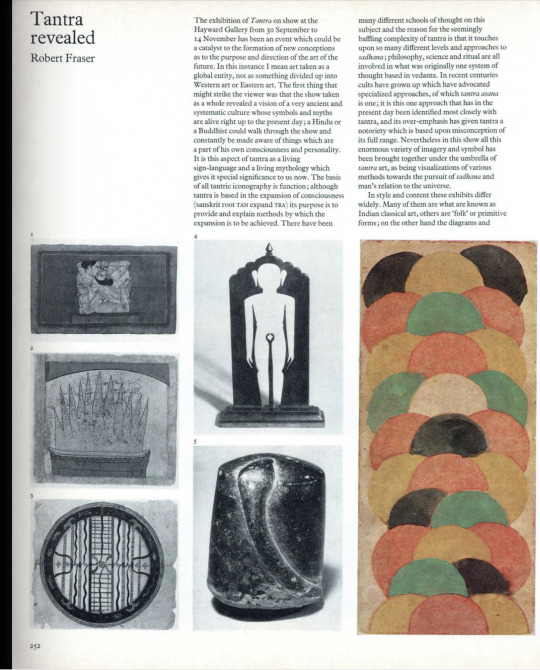
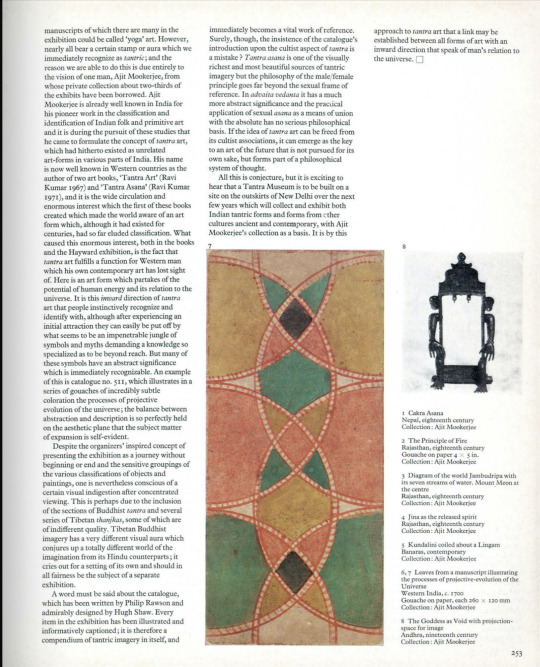
Transcription below the cut
The exhibition of Tantra on show at the Hayward Gallery from 30 September to 14 November has been an event which could be a catalyst to the formation of new conceptions as to the purpose and direction of the art of the future. In this instance I mean art taken as a global entity, not as something divided up into Western art or Eastern art. The first thing that might strike the view was that the show taken as a whole revealed a vision of a very ancient and systematic culture whose symbols and myths are alive right up to the present day; a Hindu or Buddhist could walk through the show and constantly be made aware of things which are a part of his own consciousness and personality. It is this aspect of tantra as a living sign-language and a living mythology which gives it special significance to us now. The basis of all tantric iconography is function; although tantra is based in the expansion of consciousness (Sanskrit root TAN expand TRA) its purpose is to provide and explain methods by which the expansion is to be achieved. There have been many different schools of thought on this subject and the reason for the seemingly baffling complexity of tantra is that it touches upon so many different levels and approaches to sadhana; philosophy, science and ritual are all involved in what was originally one system of thought based in vedanta. In recent centuries cults have grown up which have advocated specialized approaches, of which tantra asana is one; it is this one approach that has in the present day been identified most closely with tantra, and its over-emphasis has given tantra a notoriety which is based upon misconception of its full range. Nevertheless in this show all this enormous variety of imagery and symbol has been brought together under the umbrella of tantra art, as being visualizations of various methods towards the pursuit of sadhana and man's relation to the universe.
In style and content these exhibits differ widely. Many of them are what are known as Indian classical art, others are 'folk' or primitive forms; on the other hand the diagrams and manuscripts of which there are many in the exhibition could be called 'yoga' art. However, nearly all bear a certain stamp or aura which we immediately recognize as tantric; and the reason we are able to do this is due entirely to the vision of one man, Ajit Mookerjee, from whose private collection about two-thirds of the exhibits have been borrowed. Ajit Mookerjee is already well known in India for his pioneer work in the classification and identification of Indian folk and primitive art and it is during the pursuit of these studies that he came to formulate the concept of tantra art, which had hitherto existed as unrelated art-forms in various parts of India. His name is now well known in Western countries as the author of two art books, "Tantra Art' (Ravi Kumar 1967) and 'Tantra Asana' (Ravi Kumar1971), and it is the wide circulation and enormous interest which the first of these books created which made the world aware of an art form which, although it had existed for centuries, had so far eluded classification. What caused this enormous interest, both in the books and the Hayward exhibition, is the fact that tantra art fulfills a function for Western man which his own contemporary art has lost sight of. Here is an art form which partakes of the potential of human energy and its relation to the universe. It is this inward direction of tantra art that people instinctively recognize and identify with, although after experiencing an initial attraction they can easily be put off by what seems to be an impenetrable jungle of symbols and myths demanding a knowledge so specialized as to be beyond reach. But many of these symbols have an abstract significance which is immediately recognizable. An example of this is catalogue no. 511, which illustrates in a series of gouaches of incredibly subtle coloration the processes of projective evolution of the universe; the balance between abstraction and description is so perfectly held on the aesthetic plane that the subject matter of expansion is self-evident.
Despite the organizers' inspired concept of presenting the exhibition as a journey without beginning or end and the sensitive groupings of the various classifications of objects and paintings, one is nevertheless conscious of a certain visual indigestion after concentrated viewing. This is perhaps due to the inclusion of the sections of Buddhist tantra and several series of Tibetan thanjkas, some of which are of indifferent quality. Tibetan Buddhist imagery has a very different visual aura which conjures up a totally different world of the imagination from its Hindu counterparts: it cries out for a setting of its own and should in all fairness be the subject of a separate exhibition.
A word must be said about the catalogue, which has been written by Philip Rawson and admirably designed by Hugh Shaw. Every item in the exhibition has been illustrated and informatively captioned; it is therefore a compendium of tantric imagery in itself, and immediately becomes a vital work of reference. Surely, though, the insistence of the catalogue's introduction upon the cultist aspect of tantra is a mistake? Tantra asana is one of the visually richest and most beautiful sources of tantric imagery but the philosophy of the male/female principle goes far beyond the sexual frame of reference. In advaita vedanta it has a much more abstract significance and the practical application of sexual asana as a means of union with the absolute has no serious philosophical basis. If the idea of tantra art can be freed from its cultist associations, it can emerge as the key to an art of the future that is not pursued for its own sake, but forms part of a philosophical system or thought.
All this is conjecture, but it is exciting to hear that a Tantra Museum is to be built on a site on the outskirts of New Delhi over the next few years which will collect and exhibit both Indian tantric forms and forms from other cultures ancient and contemporary, with Ajit Mookerjee's collection as a basis. It is by this approach to tantra art that a link may be established between all forms of art with an inward direction that speak of man's relation to the universe.
****
Interesting that Fraser was based in India at this time but familiar enough with a London show to be able to write a detailed review.
Vyner says: "Characteristically, though, his reappearances in London during the four or five years he was away shed little light on his actions and whereabouts other than conveying his increased enthusiasm for all things Indian."
3 notes
·
View notes
Text
culture of India
India, often referred to as the land of diversity, is a cultural kaleidoscope that has fascinated and enchanted people from across the globe for centuries. Its rich heritage, traditions, languages, art forms, and cuisines reflect a civilization that has evolved over millennia, leaving an indelible mark on the world. In this blog, we embark on a journey to unravel the multifaceted culture ,culture of India delving into its historical roots, religious practices, artistic expressions, and modern-day manifestations.

Historical Background:
The cultural history of India can be traced back to ancient times, with evidence of human habitation dating back to the Stone Age. The subcontinent has witnessed the rise and fall of numerous civilizations, including the Indus Valley Civilization, which flourished around 3300 BCE. Subsequent waves of migration and settlement by various ethnic groups, including Aryans, Dravidians, Greeks, Persians, and Mongols, contributed to the diversity of India's cultural landscape.
Religious Diversity:
India is the birthplace of major religions such as Hinduism, Buddhism, Jainism, and Sikhism, and has also been a melting pot of diverse faiths, including Islam, Christianity, Judaism, and Zoroastrianism. The religious tolerance and syncretism prevalent in India have resulted in a vibrant tapestry of rituals, festivals, and spiritual practices that coexist harmoniously. From the grand celebrations of Diwali and Eid to the solemnity of Buddhist retreats and Sikh gurdwaras, religion permeates every aspect of Indian life, shaping its customs, beliefs, and social structures.
Art and Architecture:
Indian art and architecture are renowned for their intricacy, symbolism, and spiritual significance. The ancient rock-cut temples of Ajanta and Ellora, the majestic forts and palaces of Rajasthan, and the exquisite carvings of temples in Khajuraho are testaments to India's rich architectural heritage. The country's artistic traditions encompass a wide array of mediums, including painting, sculpture, pottery, textiles, and performing arts such as dance, music, and theater. Classical dance forms like Bharatanatyam, Kathak, Odissi, and Kuchipudi, with their roots in mythology and spirituality, continue to captivate audiences worldwide with their grace and elegance.
Cuisien:
Indian cuisine is as diverse as its culture, with each region boasting its own unique flavors, ingredients, and cooking techniques. From the fiery curries of the south to the aromatic biryanis of the north, Indian food is a gastronomic delight that tantalizes the taste buds with its rich spices and bold flavors. Staples like rice, wheat, lentils, and vegetables form the foundation of Indian meals, which are often accompanied by chutneys, pickles, and dairy products like yogurt and paneer. Street food is also a ubiquitous part of Indian culinary
culture, offering a tantalizing array of snacks and sweets that cater to every palate.
Literature and Language:
India has a rich literary tradition dating back thousands of years, with ancient texts like the Vedas, Upanishads, and epics like the Ramayana and Mahabharata shaping the cultural consciousness of the nation. Sanskrit, the classical language of ancient India, has been the vehicle for some of the world's most profound philosophical and literary works. Over the centuries, regional languages like Tamil, Telugu, Kannada, Bengali, Marathi, Gujarati, and Punjabi have flourished, producing a wealth of literature in poetry, prose, and drama. The Indian diaspora has also made significant contributions to world literature, with writers like Salman Rushdie, Arundhati Roy, and Jhumpa Lahiri garnering international acclaim for their works.
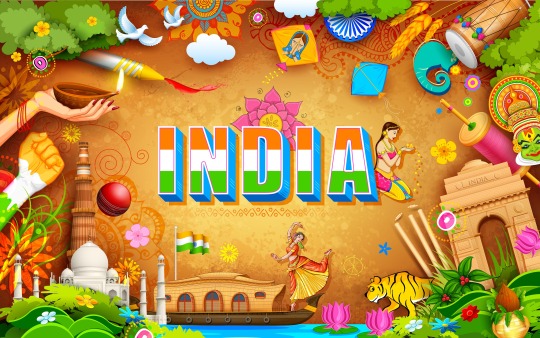
Modern Cultural Expressions:
While India's cultural heritage is deeply rooted in tradition and history, it is also a dynamic and evolving entity that continues to adapt and innovate in response to changing times. The advent of globalization, urbanization, and technology has ushered in new forms of cultural expression, from Bollywood films and indie music to contemporary art and fashion. Social media platforms like Instagram and YouTube have provided a platform for young Indian artists, musicians, and influencers to showcase their talents and connect with audiences around the world. Despite the challenges of modernization, India remains proud of its cultural heritage, embracing both tradition and innovation in equal measure.
Conclusion: India's cultural tapestry is a testament to the resilience, creativity, and diversity of its people. Across the length and breadth of the subcontinent, from the snow-capped Himalayas to the sun-drenched beaches of Kerala, the spirit of India's cultural heritage continues to thrive, enriching the lives of millions and inspiring generations to come. As we celebrate the vibrant mosaic of traditions, languages, and customs that make up the fabric of Indian society, let us also recognize the importance of preserving and safeguarding this invaluable legacy for future generations to cherish and embrace.
2 notes
·
View notes
Photo

The Pancha Kleshas ( Five Poisons of Life): अविद्यास्मितारागद्वेषाभिनिवेशाः क्लेशाः॥2.3॥ _Patanjali Yoga Sutra The Sanskrit word klesha translates to “poison” or “affliction.” This term is used to denote specific negative mental patterns that obscure our true nature. The kleshas are considered the cause of suffering in yogic and Buddhist philosophy and are to be actively overcome. The five Kleshas are 🔸Avidya (ignorance), 🔸Asmita (egoism or I-am-ness), 🔸Raga (attachment), 🔸Dvesha (repulsion and aversion), and 🔸Abhinivesha (fear of death and the will to live). Avidya (ignorance) is the misconception of our true reality, believing that the temporary is eternal, the impure is the pure, and pleasure to be painful. This false and distorted representation of reality is the primary klesha. From avidya the four other kleshas emerge. Asmita (I-am-ness) is the identification of ourselves with our ego. We create a self-image of ourselves that we believe is us, but it is not us. This self-image can contain both external (I am poor) and internal (I am a bad person) false projections. We become trapped within the projections we have created of our life. Raga (attachment) is the attraction for things that bring satisfaction to oneself. Our desire for pleasurable experiences creates mindless actions and blind-sighted vision. When we cannot obtain what we desire, we suffer. When we do obtain what we desire, our feelings of pleasure soon fade and we begin our search for pleasure again, becoming trapped in an endless cycle. Dvesha (repulsion) is the opposite of raga, aversion towards things that produce unpleasant experiences. If we cannot avoid the things we dislike, we suffer. Even thinking about unpleasant experiences produces suffering. Abhinivesha (will to live) is the deepest and most universal klesha, remaining with us until our deaths. We know that one day we will indeed die, yet our fear of death is deeply buried in our unconsciousness. . . . . . . . #adiyogaschool #yogaphilosophy #patanjaliyogasutra #yogateachertraining #patanjali #philosophy #yogaeducation #lifelessons #yogaforeveryone #yogarishikesh #yogainindia #yogaashram (at Adi Yoga School) https://www.instagram.com/p/CnjMWLMvgNH/?igshid=NGJjMDIxMWI=
#adiyogaschool#yogaphilosophy#patanjaliyogasutra#yogateachertraining#patanjali#philosophy#yogaeducation#lifelessons#yogaforeveryone#yogarishikesh#yogainindia#yogaashram
19 notes
·
View notes
Text
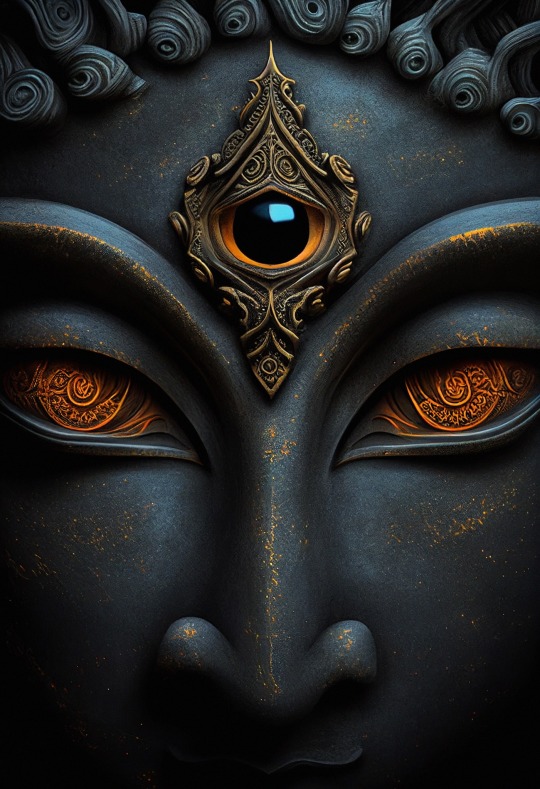
Urna, Buddha's Third Eye Talon Abraxas
Third Eye Chakra Affirmations The third eye is the energy center of intuition and divine wisdom. I will show you how can quickly start energizing this chakra using my favorite 35 third eye chakra affirmations.
Third eye chakra affirmations encourage you to become more connected with your Third Eye or Ajna Chakra.
Affirmations empower and restore your chakra and as a result, you acquire greater self-awareness and razor-sharp intuition.
The Third Eye Chakra seats the eyes of your soul. You will be able to discern the world with greater perspectives when you activate your third eye using affirmations. You will be able to see, hear, and feel the energy around you. You may even be able to perceive psychically and with very strong intuition.
Awakening your Third Eye enables you to comprehend complex concepts and situations you may not have understood in the past.
You will see other angles of your circumstances with sharper vision. You will also be able to communicate thoughts and feelings easily.
Your Third Eye Chakra The word chakra originates from the Sanskrit word for circle or a spinning wheel.
At times, chakras are referred to as the wheels of life. Chakras are aligned in ascending order from the spine’s base to the top of your head.
Chakras have perpetually been referred to as a classical element, an aspect of consciousness and related to bodily functions.
The Third Eye Chakra emanates from between the eyebrows on your forehead.
Essentially, chakras are multiple subtle body focal points used in various ancient practices of meditation.
Denominated collectively as esoteric, inner traditions of Hinduism, also known as Tantra.
The area between the eyebrows is where we direct our attention when doing third eye affirmations.
Early traditions of Hinduism reveal the concept of chakras. Between religions of India, beliefs vary.
Buddhism texts mention five chakras consistently while sources of Hinduism offer six to seven chakras.
Regardless of belief, early Sanskrit text revels meditation visualizations combine mantras and flowers as the physical body’s physical entities.
35 Third Eye Chakra Affirmations
I listen to my deepest intuition
I am in touch with internal guidance
My intuition always works to serve my highest purpose.
I and my intuition are made with perfection
I am blessed with an inner voice.
I always know exactly what to do, all the time.
I am full of wisdom and knowledge.
I always look within when making decisions
My intuition always tells me what to do.
My intuition is never wrong.
I am complete with inner knowing.
We are all growing and learning. I am growing and learning
I was born to fulfill my God-given purpose.
I love discovering new things every day.
I see life everywhere I look.
I am here for a reason.
I accept that I have weaknesses. I accept that I have strengths.
I completely accept myself.
I accept everything my third eye tells me.
I accept the things I cannot change.
I can only control my reactions to things.
I can always see clearly
I am sensitive to the world around me.
I am shielded from harm by my intuition
I can see clearly.
I attract everything I have in my reality.
I am enough as I am
I always know the right thing to do
I live to serve my highest purpose
I was born to serve a greater purpose
I am born with everything I need to survive.
Everything I need to know, I already know
My inner-knowing never fails
I always know exactly what to do in every situation.
I trust my inner guidance
Why Are Affirmations So Powerful? The reason is that words are, like everything else, a type of energy with their own frequency.
There is tremendous power in spoken words.
Words can heal or they can wound. They are powerful and can be used as a powerful weapon. They have the power to recreate your world and alter your life.
The reason that positive affirmations work is because of neuroplasticity, which is a proven scientific principle. Neuroplasticity is the ability to rewire your brain with the power of words. There is a major role that affirmations play in actualizing our subconscious and manifesting desires.
Words can be used to balance your chakras and can have a significant impact on the outcome of your health. One example of the power of affirmations is when we have a positive attitude and feel good about ourselves.
The Energy of Words This raises the body’s vibration into something positive and attracts renewed health, stronger chakra, and as a result clarity of vision, perfect health, a relaxed mind, and total well-being. Holistic tradition suggests that positive affirmations raise your chakra’s frequency and make your energetic body stronger.
When you believe and act as if something you are saying is true, and that you have acquired the outcome you long for, then the more you actualize the affirmation.
Thus when you tell yourself “I am tranquil,” This will affect your energetic chakra body and you will, inevitably, become tranquil. Scientifically, affirmations have been proven to work. The fact that they have been around for centuries means that generations of human beings have reaped the benefits of using affirmations.
The best method of proving that affirmations work is to see for yourself first hand. After a few days, you will notice real results in your life and might finally understand what has made millions of people true believers in the power of affirmations.
45 notes
·
View notes
Text

@mamoriitai : “Senpai” within her grasp, the cursed corpse wiggles, wishing to break free as she treats them like an ordinary toy. Knuckles that became bright red, her hands still felt too soft as she looked upwards, the flicker of a grinning running across pale lips. “I feel bad if I fight this puppet, it’s too cute!” she speaks with hidden intentions, the calm demeanor breaking through as long legs press against her chest, fangs that nestle within the rabbit’s mouth, she was never to be prey yet picked each battle with precision && care. “While it’s unorthodox, would you care to spare with me? Maybe then I won’t feel so bad when I lose composure, these dolls are really harsh critics!” wickedness cracks the demeanor of an innocent first year, curious with her scathing gaze, she then tilts her head before taunting. “Don’t be scared - I’ll go easy on you”
Nani? In motional response to the call, headphones were pulled out of his ears, pausing the buzzing beats of music coming from Walkman mp3 player. Someone's calling -- - and for once daring to disturb his problem-free philosophy; aka slacking, but in fact, he hardly ever slacked pointlessly, unlike his soulfull friend. In the meantime he but accidentally found and carried a strange comic book lying forgotten near one of Toro, but with vivid knowledge of Mei Mei sharing it with Utahime during their last visit from Kyōto exchange. Such a kind soul was the one who planned to deliver it back. But girls and their secrets - he did not dare to look out its content, survival instinct kicked strong. He could not internally suppress nor discard remembering the version of the Sanskrit tale - Gyokuto ; tsuki no usagi or getto (moon rabbit) for who crossed his path. '' Sayuri-san, '' his echo chimes pleasantly on the verge of curiosity but greeting her from afar all together in warm tune. Albeit using -chan instead of -san hung strongly on his tongue, such urge ended bitten back well as prevention for such application. There were times when Gioconda's countenance was easier to read than Suguru's unless he let himself a bit loose, like right now. His overall idiosyncrasy wasn't as atypical as current mannerism, though the inherently deceitful bunny would be spared to yawn in wait only for his latent manifestation of tease to debouch.
“Don’t be scared - I’ll go easy on you”

? '' Oh, what's that, some morning boldness? ''
Darkish eyebrows curiously tic-tremors in up-down flash, raising hand comes closer to Obsidian-decored lobe and low croon takes place; as if he pretentiously 'misheard' what his Kōhai said amid their mutual introspection.
Most people would be chary, but Suguru was not going to address such indisputably welcoming grin, instead, he chose to simply entertain hidden enthusiasm when challenge presented itself between sharp teeth and well-hidden veil of silver gentleness. Such carnival culmination to call Friday a day.
ㅤㅤ
ㅤㅤㅤㅤㅤㅤI am not underestimating you today, Usagi. ㅤㅤㅤㅤㅤㅤㅤㅤㅤㅤㅤㅤTry and hunt me.
ㅤㅤ
'' Are you done beating your messmates (*Haibara and Nanami ) to ascend to another level? Though, Satoru makes a better boxing bag. ''
He would also remember Satoru's one-time remark, or rather complain(?) 'Iwasaki can be just as scary as Shoko!' where Geto would just frown upon and wonder 'what's so scary about her?' Funny thing, their perception quite changed since then, but so far each first year earned his favor.
Within carefully assembled range even footsteps brought the Curse Eater closer to Sayuri in prompt cadence and the creature responsible for sonorous drumming against petite frame. Supported by chin-hand gasture - curious peer falls all the way at living, skeletal, malformation kicking to break free; quite a vertebrae nerve it got. The Cursed Corpses were usually such limpets; especially when they ambushed out of nowhere. Even more variable would be the image of him slightly pouting at evocative token of his persona not being cuter than kicking pest. Hand relocates position from chin to few patting taps upon Corpse's head. Earning them another hilarious evocation in the form of discontent noises for another person treated it as a toy.
Head tips lower, humming in full-fledging acknowledgment, '' Yaga really outdid himself with this one; it's way cuter than the rest he made so far. '' Speaking of which, lately their Sensei has been too preoccupied with preparations for lounging in the next Principal seat than to pay attention to anyone's antics; so the training grounds were all theirs to demolish to heart's content. As for himself, maybe he was even grateful for such circumstantial concurrence to withdraw him from further bitterness linked to annomaly of his technique ... and vile thoughts spinning around humanity as a whole.
" Let's drop him somewhere where he won't terrorize the rest, then -, '' but now due to contention of their tête-à-tête he found himself slightly smirking right back at her with mysteriously aureate gleam in his eyes, '' -let's see who's stark enough to eat critics of defeat. " ㅤㅤㅤㅤㅤㅤㅤ ㅤ I shall be your spar partner today.
ㅤㅤㅤㅤㅤㅤ
#mamoriitai#!Sayuri#VERSE (past) : ⑆ㅤㅤㅤcracks in golden seal.#{ SHE WANTS TO KICK HIS BUTT TODAY RIGHT?? I CAN LIT FEEL IT with my every fibre!!!! }#Geto internally: her audacity is fascinating but today ... the rabbit came to bite ... I gotta oblige ... /maybe/ or maybe not#{ The way I remembered 2007/08 mp3 and lowkey had to mention; 80s music for 90tys kids. }#{ I suppose it's time to say there is a Shiro in his life or two -surprise both happens to be yours- who earned themselves a fond spot. }#反応‚ㅤ╱ 𝐒𝐔𝐆𝐔𝐑𝐔 𝐆𝐄𝐓𝐎 reacted.
3 notes
·
View notes